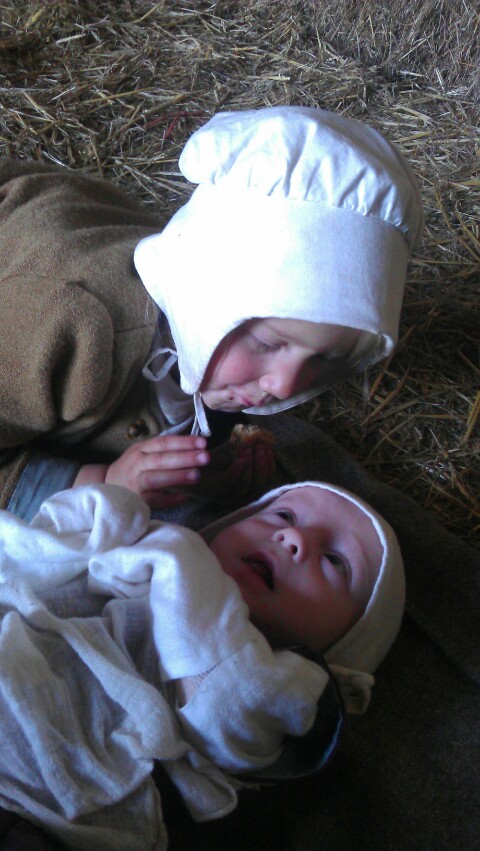
Now you know what reenactment is, from Alison’s excellent article, you may want to know a bit more about how it all works. How much work is involved in sewing the clothes, what do they eat, how do they get around? Alison’s mother Jax has written a great article about all this and more
It wasn’t an easy life, living in Tudor times. You can find that out by reading about it in a variety of places.
But I found it out by living it at Kentwell Hall.
We do reenactment. We being our entire family, from my son who was a Tudor baby aged 4 months last summer, through to my partner Tim.

The clothes are simple in some ways and complicated in others. No zips, velcro, very few buttons. Lots of hooks and eyes; warmth is provided by layering. If you’re going to reenact, the clothes you wear have to be as authentic as possible, which means hunting for natural linen of a sensible weight months beforehand, and scouring online shops for pure wool in appropriate colours for the other layers.
A woman living in Tudor times made the linens for her family, which means, as far as I can tell, that she must have spent most of her time sewing linens. Smocks, which are kind of like shirts, at least two for each family member.
Women wear petticoats, which are linen bodices and wool skirts, under a kirtle or gown (looks kind of like a pinafore dress. Eyelets and lacing are another way of using up your leisure time. My daughter sewed her own linen bodies (bodice) this year, and it has 48 eyelets. That’s 48 holes that have to be made with an awl, then sewn around, a bit like a mini buttonhole, to stop them closing up. Then you have laces that go through the holes to close your garment up.
Men don’t escape eyelets. They have a petticoat, which is like a linen waistcoat, and their hose (trousers) are pointed to it (it’s held together with leather or lace points). Their clothes are more practical; it’s amazing how much slower you move when you are weighted down with a nearly floor length linen lined wool dress. And also when you know that you’re going to be on foot all day, and carrying everything you need, which might include a baby, under your own power.
No cars. And working class Tudors walked, basically. We experience that when we come up from the campsite on to the manor on a morning. At least we don’t have to worry about lunch – we get pottage made for us by the settlers, which would have happened. If your food was included you got less money in your wages, but it saves time and effort too.
Pottage is cooked in a pot and tends to be a kind of vegetable stew of whatever is in season. No potatoes or tomatoes; they hadn’t been imported back then.
Obviously, reenactment is just acting. But I think it gives you an insight into how day to day life must have been. In my first year, I struggled with the amount of sewing I had to do, and that was even with a friend loaning me lots of stuff for the children.
Nothing can be wasted – you keep bits of wool that match in case you need patches and linen gets used and reused, cut down and eventually used as scraps for cleaning. No kitchen roll in those days for a quick wipe and throw away!
I find history from the inside utterly fascinating, and particularly because it focuses on the day to day life of ordinary people. History books focus on kings and queens and their like, and they are a tiny fraction of the population. It’s the real people that make a difference, and it’s easy to forget that if you just read the books. Living it makes it real.



